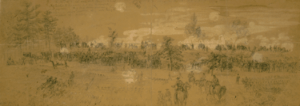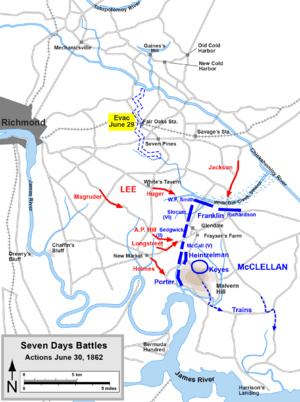Battle of Glendale facts for kids
Quick facts for kids Battle of Glendale |
|||||||
|---|---|---|---|---|---|---|---|
| Part of the American Civil War | |||||||
 Monday's fight. The battle of Charles City road. Alfred R. Waud, artist, June 30, 1862 |
|||||||
|
|||||||
| Belligerents | |||||||
| Commanders and leaders | |||||||
| George B. McClellan | Robert E. Lee | ||||||
| Units involved | |||||||
| Army of the Potomac | Army of Northern Virginia | ||||||
| Strength | |||||||
| 40,000 | 45,000 | ||||||
| Casualties and losses | |||||||
| 3,797 total (297 killed 1,696 wounded 1,804 missing or captured) |
3,673 total (638 killed 2,814 wounded 221 missing) |
||||||
The Battle of Glendale was a major fight during the American Civil War. It happened on June 30, 1862, in Henrico County, Virginia. This battle was part of the Seven Days Battles, a series of fights during the Peninsula Campaign. It is also known by other names like Frayser's Farm or Charles City Crossroads.
During this time, the Union Army, led by General George B. McClellan, was retreating. They were moving from the Chickahominy River towards the safety of the James River. Confederate General Robert E. Lee saw a chance to attack. He wanted to cut off the Union army as they moved.
Lee planned a big attack with several of his divisions. He hoped to trap and destroy McClellan's army near a place called Glendale. However, Lee's plan did not go as smoothly as he hoped. Some of his generals faced problems or moved too slowly.
Despite these issues, Confederate divisions led by Generals James Longstreet and A. P. Hill attacked the Union lines. They managed to break through in some places. But Union soldiers quickly fought back hard, closing the gaps. The battle involved intense, close-up fighting. In the end, the Union army managed to hold its ground and continue its retreat. This meant Lee's main goal of destroying the Union army was not achieved.
Contents
Background
The Seven Days Battles
The Battle of Glendale was one of many battles that happened over seven days. These fights began on June 25, 1862. At first, the Union army attacked, but General Lee quickly took control. He launched a series of attacks on the Union forces.
McClellan's Army of the Potomac was trying to get to a safe spot called Harrison's Landing on the James River. After a big battle called Gaines' Mill, McClellan left his army without clear instructions. He also did not name a second-in-command.
Most of the Union army had crossed a place called White Oak Swamp Creek by noon on June 30. About one-third of the army had reached the James River. But many soldiers were still marching between White Oak Swamp and Glendale. Glendale was a small community where several important roads met. These roads led towards the James River.
McClellan himself rode south and got on a warship called the USS Galena on the James River. This meant he was not with his troops during the battle.
Lee's Plan to Attack
As the Union army left White Oak Swamp, they had to make a sharp turn south near Glendale. This turn made them very vulnerable. Lee saw this as a great chance to attack. He ordered his Army of Northern Virginia to gather and strike the retreating Union forces.
Lee wanted his army, about 45,000 men, to attack the Union army at Glendale. His goal was to split the Union forces in two. General Huger was supposed to attack first. Then, Longstreet and A.P. Hill would join in a massive attack. General Theophilus H. Holmes was ordered to fire cannons at the retreating Union soldiers near Malvern Hill.
Opposing forces
Union Commanders
| Key Union Commanders |
|---|
|
Confederate Commanders
Battle
Lee's detailed plan for the battle did not work out well. General Huger was slowed down because Union soldiers had cut down trees to block the roads. Instead of finding another way, Huger's men spent hours cutting a new path. This delay meant he could not join the battle as planned.
General Thomas J. "Stonewall" Jackson also moved very slowly. He spent the whole day north of the main fighting. He only made weak attempts to cross a swamp and attack the Union forces there. He mostly just fired cannons, hoping to force the enemy back. Jackson's actions during these battles were not as strong as his earlier victories.
Meanwhile, the Union army also had some problems. General George A. McCall's division was supposed to defend the Glendale crossroads. But they got lost in the dark and went past their target. They only realized their mistake in the early morning. When they finally arrived, they found that nothing was protecting the road from the advancing Confederate troops. McCall's men quickly filled this gap.
To the south, General Holmes's inexperienced Confederate troops tried to attack but were easily pushed back. Union cannons and gunboats on the James River fired at them.
Around 2 p.m., Longstreet and Hill were waiting for Huger's attack to start. Longstreet heard some distant cannon fire and thought it was the signal. He began firing his cannons at McCall's line. Soon, McCall's cannons fired back.
General Lee, Longstreet, and even Confederate President Jefferson Davis were together on horseback. They came under heavy cannon fire. This fire wounded two men and killed three horses. A.P. Hill quickly told the president and generals to move to a safer spot.
Longstreet tried to stop the Union cannons, but his long-range fire was not enough. He ordered his brigades to charge the Union lines. This started a general fight around 4 p.m.
The attacks by A.P. Hill and Longstreet were the only ones that followed Lee's order. Their 20,000 men attacked the Union line of 40,000 soldiers. The main fighting happened where McCall's Pennsylvania Reserves division was positioned. These 6,000 men were just west of Frayser's Farm.
McCall's division had already fought hard in earlier battles and had many casualties. They were tired and weakened when they entered the fight at Glendale.
Three Confederate brigades attacked McCall's line. They charged through thick woods. The first brigade, led by General James L. Kemper, rushed forward. They attacked five Union artillery batteries. This caused McCall to move his reserve troops to help.
Soon, other Confederate brigades broke through the Union line. They were led by Colonel Micah Jenkins and General Cadmus M. Wilcox. The fighting moved across McCall's position. It was a very tough battle with hand-to-hand combat. Soldiers used their rifles as clubs, and officers even used their swords.
Wilcox's attack was the most successful, happening near dusk. His men found a weak spot in McCall's line. Union cannons had moved to fire at another Confederate attack, leaving their side exposed. Wilcox's soldiers charged the cannons. There was fierce hand-to-hand fighting around the guns. General McCall described it as "one of the fiercest bayonet fights that perhaps ever occurred on this continent."
McCall was captured after dark when he accidentally rode into Confederate lines. Other Union generals were also hit by stray bullets. The fighting continued until about 8:30 p.m. Longstreet used almost all his troops in the attack. The Union side brought in fresh troops one by one to fill gaps in their line.
Aftermath
The Battle of Glendale did not have a clear winner. Lee failed to stop the Union army from escaping. He also did not destroy McClellan's army. Longstreet's attacks were not well-organized. He sent his brigades in one at a time instead of attacking with a strong, combined force. Also, Huger and Jackson did not support him as Lee had planned. They stayed on the other side of White Oak Swamp.
Union forces lost 3,797 soldiers (killed, wounded, or captured). Confederate forces lost 3,673 soldiers. However, the Confederates had more killed and wounded soldiers. Longstreet's division lost more than a quarter of its men. Several generals on both sides were wounded.
After the battle, General McClellan sent a message saying his army had fought bravely. He asked for 50,000 more soldiers, which the War Department could not provide. Historians have criticized McClellan for not being present during the battle. He was on the warship Galena instead of with his troops.
One historian, Stephen W. Sears, said McClellan was "guilty of dereliction of duty" for leaving his army.
General Lee believed that if all his troops had worked together, the battle would have been a disaster for the Union. Another Confederate general, D.H. Hill, said, "Had all our troops been at Frayser's Farm, there would have been no Malvern Hill."
Edward Porter Alexander, a Confederate general, felt this battle was one of the best chances to win the war. He said, "Never, before or after, did the fates put such a prize within our reach."
Lee had one more chance to stop McClellan's army before it reached safety. This happened at the Battle of Malvern Hill on July 1.
Part of the battle took place on Gravel Hill. This was a community started for formerly enslaved people by a Quaker named Robert Pleasants before 1800. The Gravel Hill Baptist Church was built there in 1866, and the community is still close today.
Battlefield preservation
The American Battlefield Trust and its partners have helped save 726 acres (2.94 km2) of the battlefield. They have done this through more than 15 separate purchases since 1995.
Images for kids
See also
 In Spanish: Batalla de Glendale para niños
In Spanish: Batalla de Glendale para niños







